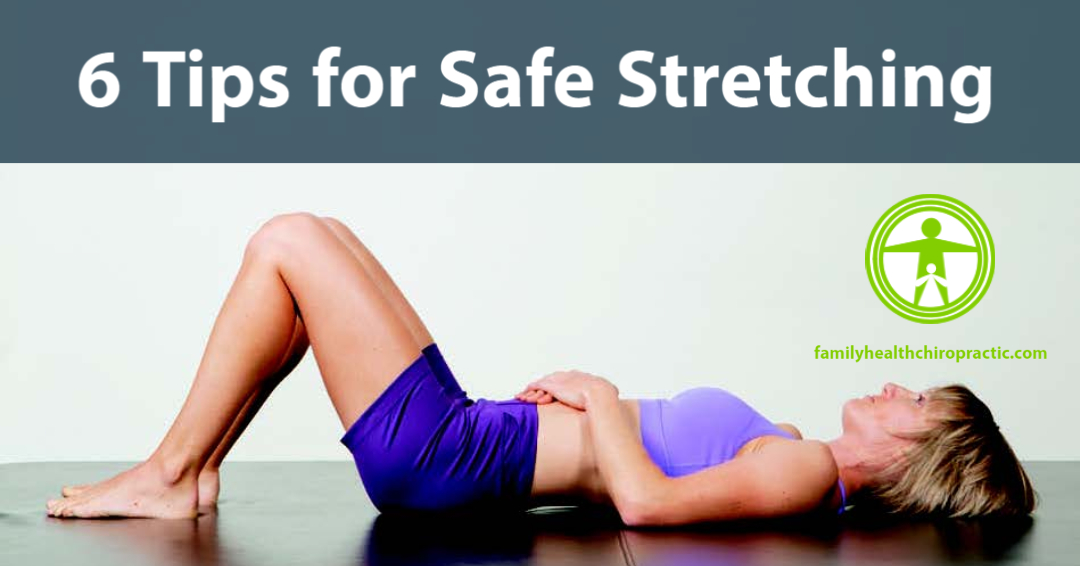When Stretching: Safety First!
It's ironic when a new patient comes into our office for their initial Chiropractic Examination and we identify that the initial cause of their problem was stretching.
Certainly, stretching is important for back pain prevention, but if you're new to stretching or it's been a while since you've stretched a particular muscle group, you're in a vulnerable position to cause more harm than good.
So while it's tempting to skip right to stretches for back pain or neck pain, it's best to think about safety first.
In this article, I'm going to share with you key concepts on the safety of stretching and 6 specific tips for safe stretches.

When to Check with a Doctor
As simple as stretching may seem, there are certainly signs and symptoms of pain following stretching that would suggest a visit to your doctor.
Of course, if you're an active individual and experienced with different types of stretching methods, this doesn't apply to you.
But its best to check with your doctor first if any of the following apply to you:
- You've had a recent surgery. Depending on the type, extent, and location of the surgery, you may need to limit stretching of the involved area until the soft tissues are healed. Ask your surgeon if there are any stretches or other activities that you should avoid or modify temporarily.
- You’ve been experiencing significant pain. While stretches may help decrease soreness, you might find them difficult to carry out if you have sharp pain. Check with a medical professional before starting your program.
- You have a chronic or unstable health condition, such as heart disease, breathing problems, high blood pressure, or diabetes.
Major Warning Signs
Generally speaking, stretching is super safe. However, there are some warning signs that you should never ignore during or after any form of physical activity.
These red flags or warning signs include:
- upper-body discomfort, including chest pain, aching, burning, tightness, or a feeling of uncomfortable fullness
- wheezing or shortness of breath that takes longer than five minutes to go away
- faintness or loss of consciousness
- sudden, sharp, or intense pain in bones or joints
- in hot, humid weather, signs of overheating, such as headache, dizziness, nausea, faintness, cramps, or palpitations
These warning signs pertain to any kind of exercise, including strength training and aerobic exercise.
Persistent or intense muscle pain that starts during a workout or right afterward, or muscle soreness that lasts more than one to two weeks, also merits a call to your doctor. (This is in contrast to normal muscle soreness, which starts 12 to 48 hours after a workout and gradually improves.)
You should also call your doctor if the routine you’ve been doing for a while without discomfort starts to cause you pain.

Health Pro's that Can Help Guide You
Team work makes the Dream Work!
If you need to tailor our stretches to your needs, various health or fitness professionals can help.
Here is a brief description of the skills offered by, and training required of, the different types of experts.
Doctors of Chiropractic
Anyone who has ever visited a chiropractor knows the importance of stretching. Surely almost every chiropractic doctor will recommend stretching as part of your daily routine, in order to keep your muscles and spine limber and keep the blood flowing.
When an adjustment is performed, the blood circulates and patients must maintain this between visits. If your chiropractor has not discussed at-home stretching in detail or you have gotten a bit rusty, then you're not getting the full benefit of your chiropractic adjustment.
Physiatrists (Physical Medicine Doctor)
Physiatrists, also known as physical medicine and rehabilitation physicians, are board-certified medical doctors who specialize in treating nerve, muscle, and bone conditions. They are among the sports medicine specialists who can diagnose and treat conditions and injuries that affect how you move, such as back problems, knee or shoulder injuries, debilitating arthritis or obesity, and stroke.
Physical Therapists
Physical therapists (PTs) help people with health conditions or injuries affecting muscles, joints, bones, or nerves by providing hands-on treatment and individualized exercise programs to restore movement in painful or debilitating conditions, or after an injury. Their expertise can be valuable, for instance, if you have suffered a lingering sprain or are recovering from a hip replacement or heart attack. Some PTs specialize in sports medicine, orthopedics, cardiopulmonary rehabilitation, geriatrics, or other areas.
Personal Trainers
Personal trainers are fitness specialists who can help ensure that you’re doing stretches and exercises properly. While encouraging and motivating you, they can fine-tune your form. Personal trainers teach new skills, change up routines to beat boredom, and safely push you to the next level.

6 Tips for Safe Stretches
Everyone – with medical conditions or not – should use these tips to help protect muscles and joints while
ensuring flexibility gains.
- Warm up first. Much like taffy or silly putty, muscles stretch more easily when warm. Our dynamic stretches can act as a warm-up for static stretches, or you can do static stretches after sports, exercise, or even marching in place with arms swinging for five minutes or dancing to a few songs. Moist heat packs or a warm shower are effective as well.
- Feel no pain. Stretch only to the point of mild tension, never to the point of pain. If a stretch hurts, stop immediately! Reset your position carefully after checking the instructions, then try again. With time and practice, your flexibility will improve.
- Pay attention to posture and good form. Posture counts whether you’re sitting, standing, or moving. Good form translates to better gains in flexibility and less likelihood of injury when stretching tight muscles. Photos of stretches tell only part of the story, so read instructions carefully to get form right.
- Focus on the muscle being stretched. You’ll notice that one side of your body often is tighter than the other. Work on balancing this over time.
- Breathe. Breathe comfortably while stretching, or use yoga breathing. Whatever you do, don’t hold your breath while you are holding a stretch.
- Practice often. You’ll make the best gains if you stretch frequently—daily, or on as many days of the week as possible. At the very least, aim to do stretches two or three times a week.

Stretching Improves Your Chiropractic Care
Arthritis, stiff backs, sore knees and tight shoulders can all suck the joy out of our lives when we experience it daily.
Stretching can help; especially when tight muscles are to blame.
Doctors of Chiropractic often prescribe stretching as part of a treatment plan to help maintain or reclaim abilities and ease discomfort.
Even if you don’t have a medical condition, you may be suffering from tight muscles that keep you from feeling your best. They can pull your body offkilter, and long hours spent at a desk—or staring down at tablet screens—may cause pain, too.
So if you're experiencing aches and pains and you're not regularly stretching, it very well could be the missing piece on your road to recovery.



